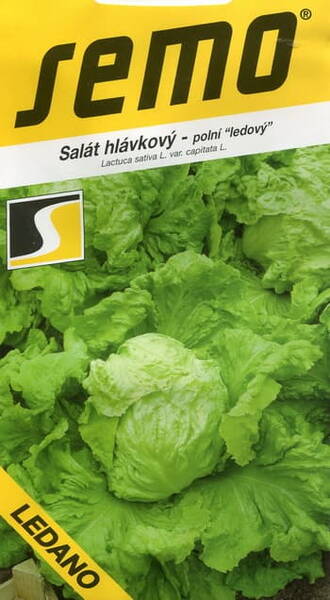Very early head lettuce iceberg type for year-round cultivation. The head is large and dense. The leaves are slightly corrugated, fleshy, tender, pleasant light green in colour and have excellent taste. Good disease resistance. Crispy head!
Large-headed variety for summer-autumn use. Vegetation period: 60-75 days.
The leaves are bright green, dense, corrugated, crispy, sweet in taste, and retain freshness for a long time. Mass of a head of cabbage - 250-350 g.
Resistant to stalking even in warm weather.
Growing conditions.
Cold-resistant and light-loving culture that tolerates frosts down to -5°C.
It grows well on light, fertile, cultivated and moist soils.
For uninterrupted production, it is recommended to sow with an interval of 15-20 days.
It likes to grow in sunny and fairly warm areas with light, well-fertilized soils with a neutral or slightly alkaline reaction. Does not tolerate acidic soils.
Lettuce requires a lot of nutrients in the soil. In addition to fertilizing with compost, ammonium sulfate (30 g/m2) and superphosphate (60 g/m2) are added to the beds before sowing (planting). The timing of sowing depends on the cultivation area, shape and even variety of lettuce. Leafy lettuces are sown from early spring to the end of August. To obtain a "green conveyor" crops are carried out at intervals of 10-15 days.
Head lettuces are best grown after 20-30 day seedlings (sowing on April 20) with planting in the ground from mid-May. From July 20 until the end of August, they are sown directly into the ground. Flower-resistant varieties can be used for staggered crops.
Seeding rate: for leaf forms - 0.3-0.4 g/m2, for head forms - 0.2 g/m2.
The landing pattern is 20 by 5 cm and 25 by 20 cm, respectively.
Seeding depth 1-2 cm. Seedlings appear on the 10th day, they must be thinned out.
In addition to frequent loosening of the beds, lettuce should be watered regularly, since heads are poorly formed in dry soil and plants shoot. Watering is carried out in large doses under the root with simultaneous fertilizing with nitrogen fertilizers. If the irrigation technology is not followed, root rot is possible.
To keep the plants fresh longer, lettuce must be harvested late in the evening or early in the morning. It is necessary to cut the lettuce at the surface of the soil, removing damaged and yellow leaves.
Lettuce is a source of essential vitamins and mineral salts. It contains carotene, vitamins B1, B2, B6, C, PP, P, E, K, minerals (potassium, calcium, magnesium, iron, phosphorus), trace elements, sugar, protein and fibre. Lettuce leaves have medicinal properties. The milky juice contains a useful alkaloid - lactucine, which gives the plant a bitter taste. This alkaloid improves digestion and metabolism, has a calming effect on the nervous system, reduces high blood pressure, strengthens the walls of blood vessels, and has a beneficial effect on sleep. Due to the high content of vitamin E, the salad is especially useful for children and pregnant women. It is also recommended for diabetics. Fresh juice is used as a remedy against chronic gastritis.
Bot.: Lactuca sativa L. var. capitata.












